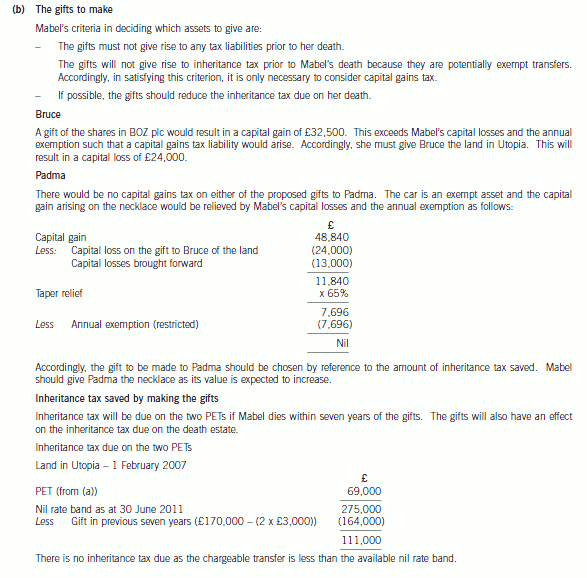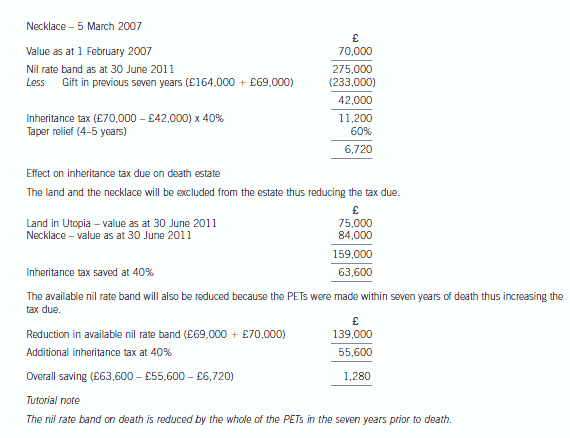ACCA报名条件有年龄限制吗?有上限吗?
发布时间:2020-02-22
随着我国经济的快速发展,一些在国际上广受认可的证书也是吸引了不少人,比如ACCA。近年来,ACCA考试报名人数不断上升,网上关于考试报名条件的相关问答也在不断增加,比如有网友就在询问ACCA报名条件是否有年龄限制。鉴于此,51题库考试学习网在下面为大家带来2020年ACCA考试报名条件的相关信息,以供参考。
ACCA报名方式比较灵活,报名要求不高,在满足学历要求的情况下,并没有年龄限制。但是如果是通过成年考试途径报考的考生,则年龄必须在21岁以上。报名参加ACCA考试,要具备以下条件之一:
1)凡具有教育部承认的大专以上学历,即可报名成为ACCA的正式学员;(只有学历要求,并未专业限制)
2)教育部认可的高等院校在校生,顺利完成所有课程考试,即可报名成为ACCA的正式学员;(一般来说,这里的在校生大多是指完成所有课程考试的大三、大四学生)
3)未符合以上报名资格的申请者,而年龄在21岁以上,可循成年考生(MSER)途径申请入会。(具体申请条件及方法,还需要小伙伴们咨询ACCA的官方网站)该途径允许学员作为ACCA校外进修生,在两年内通过F2和F3两门课程,便能以正式学员的身份继续考其他科目。(这种途径进入的考生,在通过F2、F3课程之后,仍然要按照正常考试顺序参加考试,即首先考知识模块的F1课程)
4)未符合1、2项报名资格的申请者,也可以先申请参加CAT资格考试。获得CAT资格证书后可豁免ACCAF1-F3三门课程的考试,直接进入技能课程的考试。后续考试同样要按照正常的模块顺序报名参加。
注意,注册报名随时都可以进行,但注册时间的早晚,决定了第一次参加考试的时间。通常来说,每年7月31日前注册,有资格参加同年12月份的考试;12月15日前注册,有资格参加翌年6月份考试。51题库考试学习网提醒:小伙伴们如果准备不够好,别急于报考哦。
以上就是关于ACCA考试报名条件的相关情况。51题库考试学习网提醒:ACCA考试科目是有顺序要求的,请各位考生注意。最后,51题库考试学习网预祝准备参加2020年ACCA考试的小伙伴都能顺利通过。
下面小编为大家准备了 ACCA考试 的相关考题,供大家学习参考。
(b) Mabel has two objectives when making the gifts to Bruce and Padma:
(1) To pay no tax on any gift in her lifetime; and
(2) To reduce the eventual liability to inheritance tax on her death.
Advise Mabel which item to gift to Bruce and to Padma in order to satisfy her objectives. Give reasons for
your advice.
Your advice should include a computation of the inheritance tax saved as a result of the two gifts, on the
assumption that Mabel dies on 30 June 2011. (10 marks)


Faithful representation is a fundamental characteristic of useful information within the IASB’s Conceptual framework for financial reporting.
Which of the following accounting treatments correctly applies the principle of faithful representation?
A.Reporting a transaction based on its legal status rather than its economic substance
B.Excluding a subsidiary from consolidation because its activities are not compatible with those of the rest of the group
C.Recording the whole of the net proceeds from the issue of a loan note which is potentially convertible to equity shares as debt (liability)
D.Allocating part of the sales proceeds of a motor vehicle to interest received even though it was sold with 0% (interest free) finance
The substance is that there is no ‘free’ finance; its cost, as such, is built into the selling price.
(d) There is considerable evidence to suggest that as a result of implementation problems less than 50% of all
acquisitions achieve their objectives and actually end up reducing shareholder value.
Required:
Provide Ken with a brief report on the most likely sources of integration problems and describe the key
performance indicators he should use to measure progress towards acquisition objectives. (15 marks)
(d) Many academic studies, together with actual managerial experience, point to the post-acquisition integration phase as being
the key to an acquirer achieving their acquisition objectives. In particular, the creation (or destruction) of shareholder value
rests most heavily on the success of the integration phase, which in turn helps determine whether the acquirer has chosen
the ‘right’ target company and paid the right price for it. One source strongly argues that the capability to manage the
integration of the two organisational sturctures, in particular the conversion of information systems and retention and
motivation of key employees, determines how much value can be extracted from the combined entities. The ability to manage
the integration process will therefore affect the success of the prior phases of the acquisition process – the search for and
screening of potential candidates, the effective carrying out of due diligence, financial evaluation and successful negotiation
of the deal.
Unfortunately, the failure to develop the necessary integration skills dooms many firms to continued failure with their
acquisitions, though some firms are conspicuously successful in developing such a capability and they gain significant
competitive advantage over their less successful competitors and create value for the stakeholders. One explanation for this
conspicuous inability to learn from past acquisition experience, compared with other activities in the value chain, lies with
their infrequency and variety. ‘No acquisition is like another.’ Much of the difficulty however lies in the complex
interrelationship and interdependency between the activities being integrated and a consequent difficulty of knowing what is
causing performance problems. Thus, it is no good communicating all the positives to the customer if there is a failure to
retain and motivate the sales force. To this complexity of integrating different processes is added the problem of developing
appropriate measures of and accurate monitoring of the integration processes. In one study of US bank acquirers, only 40%
had developed specific performance measures for the systems conversion process, despite the critical importance of systems
integration to efficient operation of the combined banks. Key performance indicators need to be set in the areas previously
identified as offering major opportunities for synergies. These synergies will affect both the cost and revenue side of the
business. Real cost reductions are clearly a major reason for the proposed acquisition in view of the competitive environment
faced. Equally relevant are appropriate measures of customer service. Each area will need appropriate key performance
indicators showing priorities and relevant timescales for achievement.
Therefore, there is a critical need to learn from previous experience and the relationship between decisions made, actions
taken and performance outcomes. This knowledge and experience needs to be effectively recorded and shared. It can then
influence the earlier phases of the acquisition referred to above, thus leading to a virtuous circle of better integration and
acquisitions that actually enhance value. In so doing, acquisitions can lead to faster growth and better performance.
(b) A sale of industrial equipment to Deakin Co in May 2005 resulted in a loss on disposal of $0·3 million that has
been separately disclosed on the face of the income statement. The equipment cost $1·2 million when it was
purchased in April 1996 and was being depreciated on a straight-line basis over 20 years. (6 marks)
Required:
For each of the above issues:
(i) comment on the matters that you should consider; and
(ii) state the audit evidence that you should expect to find,
in undertaking your review of the audit working papers and financial statements of Keffler Co for the year ended
31 March 2006.
NOTE: The mark allocation is shown against each of the three issues.
(b) Sale of industrial equipment
(i) Matters
■ The industrial equipment was in use for nine years (from April 1996) and would have had a carrying value of
$660,000 at 31 March 2005 (11/20 × $1·2m – assuming nil residual value and a full year’s depreciation charge
in the year of acquisition and none in the year of disposal). Disposal proceeds were therefore only $360,000.
■ The $0·3m loss represents 15% of PBT (for the year to 31 March 2006) and is therefore material. The equipment
was material to the balance sheet at 31 March 2005 representing 2·6% of total assets ($0·66/$25·7 × 100).
■ Separate disclosure, of a material loss on disposal, on the face of the income statement is in accordance with
IAS 16 ‘Property, Plant and Equipment’. However, in accordance with IAS 1 ‘Presentation of Financial Statements’,
it should not be captioned in any way that might suggest that it is not part of normal operating activities (i.e. not
‘extraordinary’, ‘exceptional’, etc).
Tutorial note: However, note that if there is a prior period error to be accounted for (see later), there would be
no impact on the current period income statement requiring consideration of any disclosure.
■ The reason for the sale. For example, whether the equipment was:
– surplus to operating requirements (i.e. not being replaced); or
– being replaced with newer equipment (thereby contributing to the $8·1m increase (33·8 – 25·7) in total
assets).
■ The reason for the loss on sale. For example, whether:
– the sale was at an under-value (e.g. to a related party);
– the equipment had a bad maintenance history (or was otherwise impaired);
– the useful life of the equipment is less than 20 years;
– there is any deferred consideration not yet recorded;
– any non-cash disposal proceeds have been overlooked (e.g. if another asset was acquired in a part-exchange).
■ If the useful life was less than 20 years, tangible non-current assets may be materially overstated in respect of other
items of equipment that are still in use and being depreciated on the same basis.
■ If the sale was to a related party then additional disclosure should be required in a note to the financial statements
for the year to 31 March 2006 (IAS 24 ‘Related Party Disclosures’).
Tutorial note: Since there are no specific pointers to a related party transaction (RPT), this point is not expanded
on.
■ Whether the sale was identified in the prior year audit’s post balance sheet event review. If so:
– the disclosure made in the prior year’s financial statements (IAS 10 ‘Events After the Balance Sheet Date’);
– whether an impairment loss was recognised at 31 March 2005.
■ If not, and the equipment was impaired at 31 March 2005, a prior period error should be accounted for (IAS 8
‘Accounting Policies, Changes in Accounting Estimates and Errors’). An impairment loss of $0·3m would have
been material to prior year profit (12·5%).
Tutorial note: Unless this was a RPT or the impairment arose after 31 March 2005 a prior period adjustment
should be made.
■ Failure to account for a prior period error (if any) would result in modification of the audit opinion ‘except for’ noncompliance
with IAS 8 (in the current year) and IAS 36 (in the prior period).
(ii) Audit evidence
■ Carrying amount ($0·66m as above) agreed to the non-current asset register balances at 31 March 2005 and
recalculation of the loss on disposal.
■ Cost and accumulated depreciation removed from the asset register in the year to 31 March 2006.
■ Receipt of proceeds per cash book agreed to bank statement.
■ Sales invoice transferring title to Deakin.
■ A review of maintenance expenses and records (e.g. to confirm reason for loss on sale).
■ Post balance sheet event review on prior year audit working papers file.
■ Management representation confirming that Deakin is not a related party (provided that there is no evidence to
suggest otherwise).
声明:本文内容由互联网用户自发贡献自行上传,本网站不拥有所有权,未作人工编辑处理,也不承担相关法律责任。如果您发现有涉嫌版权的内容,欢迎发送邮件至:contact@51tk.com 进行举报,并提供相关证据,工作人员会在5个工作日内联系你,一经查实,本站将立刻删除涉嫌侵权内容。
- 2019-01-06
- 2020-02-28
- 2020-01-10
- 2020-01-10
- 2019-01-06
- 2019-01-06
- 2019-01-06
- 2020-01-09
- 2020-01-10
- 2019-01-17
- 2020-01-10
- 2020-02-22
- 2020-01-09
- 2020-01-09
- 2020-04-11
- 2020-01-09
- 2020-01-10
- 2020-01-10
- 2020-01-03
- 2020-01-10
- 2020-02-22
- 2020-01-03
- 2019-01-06
- 2020-01-09
- 2020-01-09
- 2020-01-01
- 2020-02-26
- 2020-01-09
- 2020-01-10
- 2020-01-10